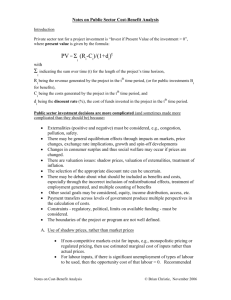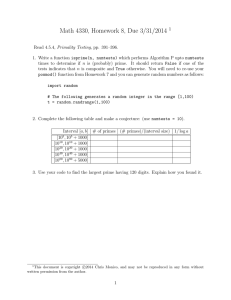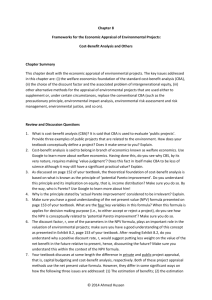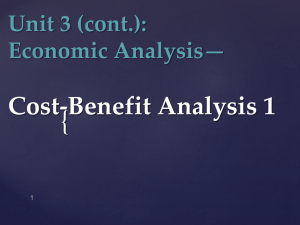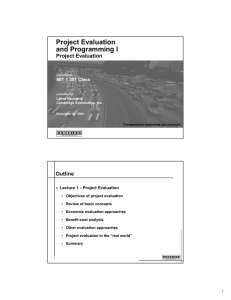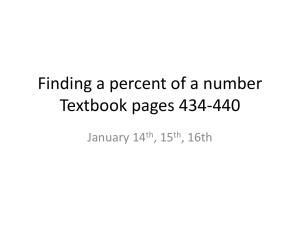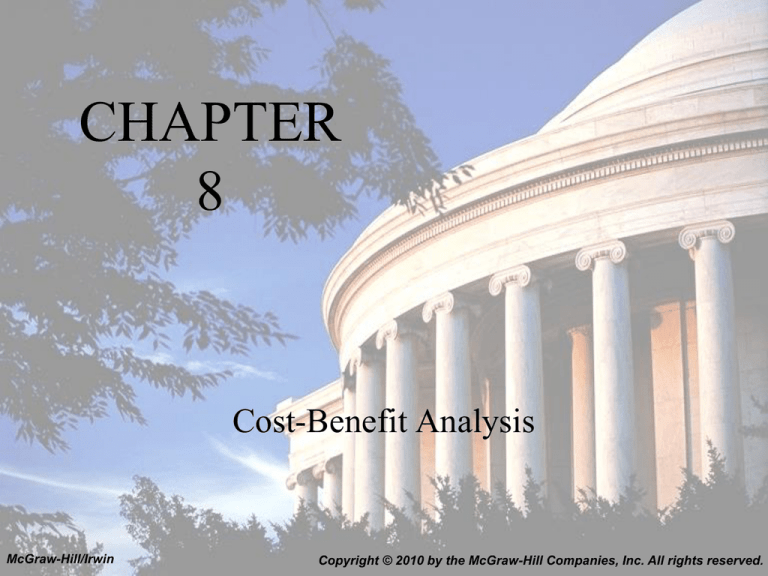
CHAPTER
8
Cost-Benefit Analysis
McGraw-Hill/Irwin
Copyright © 2010 by the McGraw-Hill Companies, Inc. All rights reserved.
Projecting Present Dollars into the Future
R0 = $1000
R1 = $1000*(1+.01) = $1010
R2 = $1010*(1+.01) = $1020.10
R2 = $1000*(1+.01)2 = $1020.10
RT = R0*(1+r)T
8-2
Projecting Future Dollars into the Present
R0 = $1000
R1 = $1000*(1+.01) = $1010
R2 = $1010*(1+.01) = $1020.10
R2 = $1000*(1+.01)2 = $1020.10
RT = R0*(1+r)T
Present Value R0 = RT/(1+r)T
discount factor
discount rate
8-3
Present Value of a Stream of Money
R1
R2
RT
PV R0
...
2
T
(1 r ) (1 r )
(1 r )
8-4
Inflation
(1 ) R1
(1 ) 2 R2
(1 ) T RT
PV R0
...
2
2
(1 )(1 r ) (1 ) (1 r )
(1 ) T (1 r ) T
8-5
Private Sector Project Evaluation
B2 C2 B3 C3
BT CT
PV B1 C1
...
2
T
1 r
(1 r )
(1 r )
Annual Net Return
PV
Admissible
Year
R&D
Advertising
R=
R&D
Advertising
0
$1,000
-$1,000
0
$150
$200
Preferable
Present Value Criteria
1
600
0
0.01
128
165
2
0
0
0.03
86
98
3
550
1,200
0.05
46
37
0.07
10
-21
8-6
Internal Rate of Return
B2 C2 B3 C3
BT CT
PV B1 C1
...
0
2
T
1
(1 )
(1 )
Project
Year 0
Year 1
ρ
Profit
PV
X
-$100
$110
10%
$4
3.77
Y
-$1,000
$1,080
8%
$20
18.87
8-7
Benefit-Cost Ratio
B1
B2
BT
B B0
...
2
T
1 r (1 r )
(1 r )
C1
C2
CT
C C0
...
2
T
1 r (1 r )
(1 r )
Benefit-cost ratio = B/C
8-8
Problems with the Benefit-Cost
Ratio
Method
B
C
B/C
I
$250
$100
2.5
II
$200
$100
2.0
I: Subtract
$40 mistake
from B
I: Add $40
mistake to C
$210
$100
2.1
$250
$140
1.79
8-9
Discount Rate for Government
Projects
• Returns in Private Sector
• Social Discount Rate
– Paternalism
– Market Inefficiency
• Discounting and the Economics of Climate
Change
• Government Discounting in Practice
8-10
• Market Prices
• Adjusted Market Prices
– Shadow price
• Monopoly
• Taxes
• Unemployment
• Consumer Surplus
Price per pound
of avocados
Valuing Public Benefits and Costs
$2.89
$1.35
e
b
d
Sa
c
g
Sa’
Da
A0
A1 Pounds of
avocados per year
8-11
Inferences from Economic
Behavior
• The Value of Time
• The Value of Life
– Lost earnings
– Probability of death
8-12
Valuing Intangibles
• Subverting cost-benefit exercises
• Reveal limits on intangibles
• Cost-effectiveness analysis
8-13
Games Cost-Benefit Analysts Play
• The Chain-Reaction Game
• The Labor Game
• The Double-Counting Game
8-14
Distributional Considerations
• Hicks-Kaldor Criterion – a project should be
undertaken if it has positive net present value,
regardless of distributional consequences
• Government costlessly corrects any
undesirable distributional aspects
• Weighted benefits
8-15
Uncertainty
Project
Benefit
Probability
EV
X
$1,000
1.00
$1,000
0
0.50
Y
$2,000
0.50
$1,000
Certainty Equivalent
8-16
Are Reductions in Class Size
Worth It?
•
•
•
•
Discount rate
Costs
Benefits
The Bottom Line and Evaluation
8-17
Use (and Nonuse) by Government
• Using Cost-Benefit Analysis
• Not Using Cost-Benefit Analysis
– Clean Air Act
– Endangered Species Act
– Food, Drug, and Cosmetic Act
8-18
Utility
Calculating the Certainty Equivalent Value
U
U(E + y)
U*
U(E)
Certainty Equivalent
Expected income
E
C
I*
E+y
Income per year
8-19


